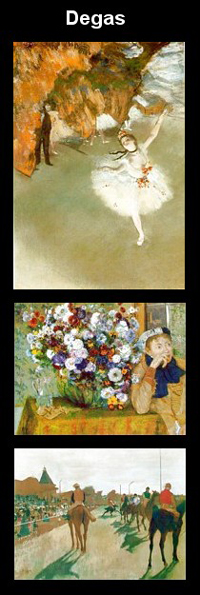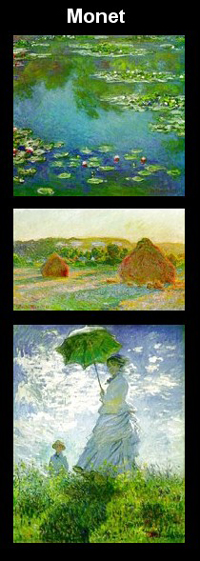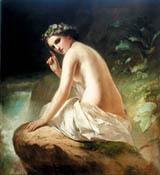Text 1. A bather or a nymph? Fon Neff’s painting


 A picturesque painting by Timophey Andreevich fon Neff (1805–1876), which is located in one of private St. Petersburg collections is a version of the famous composition of this artist known as «A Bather» («A Nymph»). This is a symbolic and allegorical painting the comprehension of which, in spite of the apparent simplicity, demands extensive emotional efforts.
A picturesque painting by Timophey Andreevich fon Neff (1805–1876), which is located in one of private St. Petersburg collections is a version of the famous composition of this artist known as «A Bather» («A Nymph»). This is a symbolic and allegorical painting the comprehension of which, in spite of the apparent simplicity, demands extensive emotional efforts.
| |
| Timophey Andreevich Neff. «A Bather». Canvas, oil. 137,0 x 124,5. Rome 1859. St. Petersburg private collection. |
Nymphs are deities, which personify natural phenomena and are considered to be the daughters of Zeus and Geya. Nymphs used to participate in the counsel of Gods, were their lovers and mothers of heroes. Cathedrals, devoted to nymphs, were situated near springs, in grottos. In art, they were depicted as charming semi-nude girls. Nymphs, endowed with beautiful voices and the gift of foresight, were considered to inspire poets to compose epic, heroic and love verses.
There is a wreath of callistegiya on the head of the bather. This Southern plant of creeper family is connected with the name of an Arcadian nymph Callisto. As a Zeus’ lover, she bore him a son Arcada who afterwards became the forefather of all citizens of mountain Arcadia. Pursued by jealous Gera, a wonderful nymph personified supernatural skills, everything that live and lifeless nature embrace, mountain Arcadia, a country, which, in ancient time, used to be associated with simple and careless life in the open air. In XVII century, a new artistic plot was introduced, «Et ego in Arcadia beata vixi…». At Romantism period, this theme was filled in with idyllic sadness for unattainable joy and easiness of being, which, alas, fell into oblivion.
All his life, Timophey Andreevich fon Neff experienced irresistible craving for the antiques, which used to be his «religion». His nymph is represented as a deity of nature, a muse, which grants the artist his artistic power. There is a guess whether the bather is an allegorical portrait of Grand Duchess Maria Nicolaevna, the president of Imperial Academy of Art and the chairman of Imperial Society for Artists Encouragement. The Russian Art of XX century evidences many portraits of noblemen presented as Olympic heroes. Peter I was depicted as Neptun, Catherine II as Minerva, Count Grigiriy Grigiryevich Orlov as Ares, Count Alexander Vasilyevich Suvorov as Mars. In this case, physiognomic resemblance did not seem to have a prevailing importance. Such portraits were, mainly, the expression of divine essence of great persons. The assertion that the patroness of Arts, Grand Count Maria Nicolaevna (1819–1876), is implied in the image of the nymph-muse does not contradict with iconographic features of the master’s art.
It is impossible to distinguish the only plastic prototype of fon Neff’s composition. Here, the influence of ancient sculptors and Italian artists of Renaissance is evident. The master had all chances to know Andrey Mantenier’s engraving «The battle of sea deities» (ca. 1485–1488), which presents a nymph who is looking back at the viewer. In its turn, this figure was borrowed by Mantenier from the relief at a Romanian sarcophagus of II century A.D. We also recall Julio Bonacone’s work (ca. 1510 – ca. 1576) «The Kidnapping of Europe» and, of course, Markantonio Raimondy’s «Paris’ justice» (ca. 1483–1534) where one of the nymph is sitting near the stream.
We can only speculate about the former location of the painting, which was not known to wide public (1859, previously – the property of Tsar Court, now is located in Omsk). It hardly was exhibited in Ladies room or in a joint dark corridor of the Winter Palace, above Saltykov proezd. There was only European and Eastern erotic graphics. In the Farm pavilion, Children Village, and in Peterhof Residence (in 1920s it was trespassed to K.E. Voroshilov), there hung paintings of seemingly frivolous content, which could only be viewed by the selected members of the Tsar family. Judging by the ethics of Christian Church of Russia of XIX century, fon Neff’s «A Bather» with its classical plot but with new presentation of nude female body, was not only considered to be a work of high academic style but also something too frivolous. It is doubtlessly possible to ascertain that up to 1917 «A Bather» (1859) was only exposed to the selected ones. After the Revolution, it was confiscated from the former Tsar collection and added to the Antiques and, in 1925, it entered the Omsk collection through Leningrad department of the State museum fund. So, this painting is less known to the public then the one kept in the State Russian Museum.
The famous «Bather» (canvas, oil; 153 x 153 cm; a painting on rectangular canvas, inserted into a circle) painted by Timophey Andreevich fon Neff (The State Russian Museum) has the author’s signature and his indication of the place and the time of its production: «Roma 1858 / Neff». The following year the artist painted a little bigger author version of the composition: canvas, oil; diameter — 160 cm (circle), signed as: «Roma 1859 / Neff» (Omsk Regional Museum of Art). Both paintings used to be the property of tsars. But if the painting of 1858 was passed in 1859 to the Emperor Alexander III Russian museum by the Imperial Hermitage, the brilliant author version of the painting dated of 1859 was still the property of the Court. Rather similar author versions of «Bather» dated of 1858 and 1859, of course, were not exhibited in the Imperial Hermitage side by side.
 Having returned from Rome to St. Petersburg (1859), the artist brought both canvases with the encircled compositions with him. Moreover, it is possible to ascertain that, at least, one of the «Bathers» was bought by Alexander II in the same 1859, for already in 1860 it was copied in the Imperial Hermitage. This copy (canvas, oil) is painted and dated by the copyist: «Рокачевскiй. 1860. С Неффа» (the location is unknown; previously – Charkov, the Museum of Fine Arts at the Charkov University). Now it is impossible to determine which of the two originals Rokachevsky copied. Apparently, in the Imperial Hermitage, where the students of the Imperial Academy of Art were allowed to make unlimited number of copies, another version of «Bather» was made (St. Petersburg, private collection). This copy (canvas, oil; diameter – 142, circle) has the author’s signature: «Копiя с Т.А. фонъ Неффа» and the copyist monogram.
Having returned from Rome to St. Petersburg (1859), the artist brought both canvases with the encircled compositions with him. Moreover, it is possible to ascertain that, at least, one of the «Bathers» was bought by Alexander II in the same 1859, for already in 1860 it was copied in the Imperial Hermitage. This copy (canvas, oil) is painted and dated by the copyist: «Рокачевскiй. 1860. С Неффа» (the location is unknown; previously – Charkov, the Museum of Fine Arts at the Charkov University). Now it is impossible to determine which of the two originals Rokachevsky copied. Apparently, in the Imperial Hermitage, where the students of the Imperial Academy of Art were allowed to make unlimited number of copies, another version of «Bather» was made (St. Petersburg, private collection). This copy (canvas, oil; diameter – 142, circle) has the author’s signature: «Копiя с Т.А. фонъ Неффа» and the copyist monogram.
The presence of the old copies of «Bather» testifies high importance of these compositions for the history of Russian Art. The creation of author versions, which are not inferior to the first version in terms of the artistic value, was the characteristic feature of Timophey Andreevich fon Neff’s art. So, for instance, there is his own painting version (Chelyabinsk, The Regional Painting Gallery) of a part of the composition of his famous painting «Two girls in grotto» (1859, The State Russian Museum).
A painting from a private St. Petersburg collection («Roma fec./ Neff. 1859»), is doubtlessly, an authentic work of Timophey Andreevich fon Neff. It is slightly different in size but, mainly, it differs by the rectangular format of the picture from the encircled analogous painting opuses located in St. Petersburg and Omsk. The landscape of the painting is more spacious and also is more romantic. Signed and dated by the artist himself, the «Bather» of 1859 (private property), created in Rome with great inspiration, is irreproachable in terms of mastery. The only surprise is that in result of some games of fate the canvas had long been in shadow, apart from the eyes of the historians of arts. This fon Neff’s «Bather» is, of course, worth complementing the state museum collection and exhibiting to wide public.
Text 2.
Impressionism 
Impressionism was a 19th century art movement, that began as a loose association of Paris-based artists who began publicly exhibiting their art in the 1860s. The name of the movement is derived from Claude Monet’s «Impression, Sunrise» (Impression, soleil levant). Critic Louis Leroy inadvertently coined the term in a satiric review published in «Le Charivari».
The influence of Impressionist thought spread beyond the art world, leading to Impressionist music and Impressionist literature. Characteristic of impressionist painting are visible brushstrokes, light colors, open composition, emphasis on light in its changing qualities (often accentuating the effects of the passage of time), ordinary subject matter, and unusual visual angles.Impressionism also describes art done in this style, but outside of the late 19th century time period.
Overview
Radicals in their time, early impressionists broke the picture making rules of earlier generations. They captured a fresh and original vision that seemed strange and unfinished to their viewing public. Rejecting attempts to portray ideal beauty, the impressionists looked instead to beauty in candid day-to-day living. They painted «en plein air» (outdoors) rather than in a studio as was the custom, capturing the momentary and transient aspects of sunlight.
Impressionist paintings feature short, «broken» brush strokes of pure, untinted and unmixed pigments that give an appearance of spontaneity and vitality. The surfaces of the paintings are often textured with thick paint, a characteristic setting them apart from their predecessors in which smooth blending minimized the perception that one is looking at paint on canvas. Compositions are simplified and innovative, and the emphasis is on overall effect rather than upon details.
Beginnings
In an atmosphere of change as Emperor Napoleon III rebuilt Paris and waged war, the Académie des beaux-arts dominated the French art scene in the middle of the 19th century. Art at the time was considered a conservative enterprise whose innovations fell within the Académie's defined borders. The Académie set the standards for French painting. In addition to dictating the content of paintings (historical and religious themes, and portraits were valued), the Académie commanded which techniques artists used. They valued somber, conservative colours. Refined images, mirroring reality when closely examined, were esteemed. The Académie encouraged artists to eliminate all traces of brush strokes — essentially isolating art from the artist's personality, emotions, and working techniques.
The Académie held an annual art show — Salon de Paris, and artists whose work displayed in the show won prizes and garnered commissions to create more art. Only art selected by the Académie jury exhibited in the show. The standards of the juries about suitable art for the salon reflected the values of the Académie.
 The young artists painted in a lighter and brighter style than most of the generation before them, extending the realism style of Gustave Courbet, Winslow Homer and the Barbizon school. They submitted their art to the Salon, and the juries rejected the pieces. A core group of them, Claude Monet, Pierre Auguste Renoir and Alfred Sisley, studied under Charles Gleyre. The three of them became friends and often painted together.
The young artists painted in a lighter and brighter style than most of the generation before them, extending the realism style of Gustave Courbet, Winslow Homer and the Barbizon school. They submitted their art to the Salon, and the juries rejected the pieces. A core group of them, Claude Monet, Pierre Auguste Renoir and Alfred Sisley, studied under Charles Gleyre. The three of them became friends and often painted together.
In 1863, the jury rejected «The Luncheon on the Grass» (Le déjeuner sur l'herbe) by Édouard Manet primarily because it depicted a nude woman with two clothed men on a picnic. According to the jury nudes were acceptable in historical and allegorical paintings, but to show them in common settings was forbidden. Manet felt humiliated by the sharply worded rejection of the jury, which set off a firestorm among many French artists. Although Manet did not consider himself an impressionist, he led discussions at Café Guerbois where the impressionists gathered, and influenced the explorations of the artistic group.
After seeing the rejected works in 1863, Emperor Napoleon III decreed that the public be allowed to judge the work themselves, and the Salon des Refusés (Salon of the Refused) was organized. For years art critics rebuked the Salon des Refusés, and in 1874 the impressionists (though not yet known by the name) organized their own exhibition.
After seeing the show, critic Louis Leroy (an engraver, painter, and successful playwright), wrote a scathing review in the «Le Charivari» newspaper. Targeting a painting by a then obscure artist he titled his article, «The Exhibition of the Impressionists». Leroy declared that «Impression, Sunrise» (Impression, soleil levant) by Claude Monet was at most a sketch and could hardly be termed a finished work.
 Leroy wrote, in the form of a dialog between viewers, «Impression — I was certain of it. I was just telling myself that, since I was impressed, there had to be some impression in it … and what freedom, what ease of workmanship! Wallpaper in its embryonic state is more finished than that seascape».
Leroy wrote, in the form of a dialog between viewers, «Impression — I was certain of it. I was just telling myself that, since I was impressed, there had to be some impression in it … and what freedom, what ease of workmanship! Wallpaper in its embryonic state is more finished than that seascape».
The term «impressionists» gained favor with the artists, not as a term of derision, but as a badge of honor. The techniques and standards within the movement varied, but the spirit of rebellion and independence bound the movement together.
Impressionist techniques:
Short, thick strokes of paint in a sketchy way, allowing the painter to capture and emphasize the essence of the subject rather than its details.
They left brush strokes on the canvas, adding a new dimension of familiarity with the personality of the artist for the viewer to enjoy.
Colours with as little pigment mixing as possible, allowing the eye of the viewer to optically mix the colors as they looked at the canvas, and providing a vibrant experience for the viewer.
Impressionists did not tint (mix with black) their colours in order to obtain darker pigments. Instead, when the artists needed darker shades, they mixed with complementary colours. (Black was used, but only as a colour in its own right.)
They painted wet paint into the wet paint instead of waiting for successive applications to dry, producing softer edges and intermingling of color.
Impressionist avoided the use of thin paints to create glazes which earlier artists built up carefully to produce effects. Rather, the impressionists put paint down thickly and did not rely upon layering.
Impressionists discovered or emphasized aspects of the play of natural light, including an acute awareness of how colours reflect from object to object.
In outdoor paintings, they boldly painted shadows with the blue of the sky as it reflected onto surfaces, giving a sense of freshness and openness that was not captured in painting previously. (Blue shadows on snow inspired the technique.)
They worked «en plein air» (outdoors)
Previous artists occasionally used these techniques, but impressionists employed them constantly. Earlier examples are found in the works of Frans Hals, Peter Paul Rubens, John Constable, Theodore Rousseau, Gustave Courbet, Camille Corot, Eugene Boudin, and Eugène Delacroix.
Impressionists took advantage of the mid-century introduction of premixed paints in tubes (resembling modern toothpaste tubes) which allowed artists to work more spontaneously both outdoors and indoors. Previously, each painter made their own paints by grinding and mixing dry pigment powders with linseed oil.

